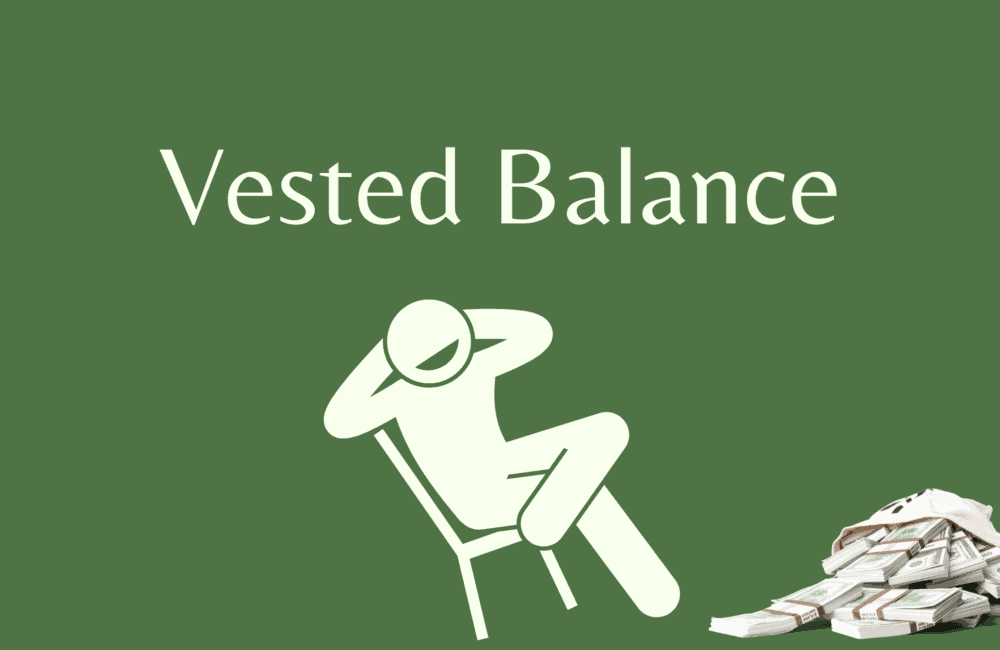If you look into the meaning of the words, you understand that vested balance refers to the money or balance in your account that’s completely yours to be used.
Let’s understand this in a bit more depth.
What Is A Vested Balance?
A vested balance can be defined as the amount that you have complete control over and belongs to only you. In case you leave a job or quit your company, this amount of money is always yours to take with you.
So, when you have an employer-sponsored retirement plan, then you have your employer pay on your behalf along with which you also have to contribute some amount. A fixed period is designated for the plan and for that time you have to be committed to your work to get the benefit from the retirement plan. This time for which you have to work with the employer is called the “Vesting Schedule”. The vesting schedule differs from one plan to the other and can be anywhere from a few months to a few years.
Vesting is a legal term that allows you to make for yourself a future retirement plan without actually being involved in it and only by working for someone.
This method is also good for an employer as it assures that the employee will remain working for the employer for a certain period which is already decided, i.e., for the vesting schedule.
As already mentioned, some of the amounts of the plan are contributed by you and belong to you. In case you quit the job and leave, this amount of money remains yours and you have the right to take it.
Also Read: What Does an Estate Planning Attorney Do?
Withdrawing Your Vested Balance
Although the contribution you make completely belongs to you, that doesn’t mean you can withdraw it whenever you want, you have to follow some rules and policies and if not quitting your job, then you would have to wait for the whole schedule to complete to receive it. Withdrawing between the terms might lead you to penalties.
The vesting percentage cannot change even if you leave the money there or take some time before withdrawing it. The vesting percentage depends only on the vesting schedule and if you have completed your term according to the employer’s will.
All the remaining money in your account that is not your contribution but is contributed by your employer isn’t vested and thus is known as the “Unvested Balance”.
What Are The Types Of Vesting?
Vesting can vary and based on the plan the vesting schedule and depends on the plan as to how soon you’ll be vested.
Your employer can change the way you will be vested and can make you vested sooner.
The two main types of Vesting can be explained as:
1. Cliff Vesting
In this type of vesting the match is made available to you only after a certain period or after the vesting schedule. It becomes 100% available at once and there’s no gradual vesting. All the matches are unvested before this particular period completes.
This type of vesting has a vesting schedule that lasts for about three years and on the completion of these three years, all the matches are made available to you at once. The plan can also be more or less than three years based on the plan.
2. Graded Vesting
In this type of vesting, all the matches aren’t released at once but a certain portion of the vesting is released after a certain period which is usually after a year. Thus, the vesting process is gradual and not sudden.
This type of vesting usually has a vesting schedule that lasts from two to six years. The match released every year is equally distributed among these years based on how to spread out the plan is. Again, the vesting schedule might vary based on the employer’s choice.
Also Read: Types of Inflation: 3 Most Critical 5 More
Frequently Asked Questions
How Is Vesting Calculated?
There are two main methods of calculating vesting, these are based on hours of vesting which means that a particular number of hours can be considered as a year of service or by the time elapsed which means the time from the hiring of the employer up to a year of service.
What Is Stock Vesting?
In stock vesting you get the right to buy shares in the future by the process of vesting.
Can I Withdraw My Vested Balance?
In 401(k) vesting, you can withdraw the amount that you have contributed.
What Is Reverse Vesting?
Reverse Vesting is a reselling of a part or all of the shares by the founder to the co-founders in case of the departure.
Can An Employer Cancel A Vested Plan?
Yes, an employer might be able to end a plan by the process of “Plan Termination”.



